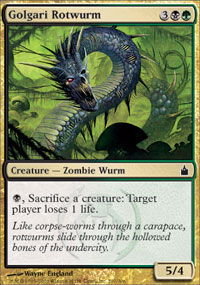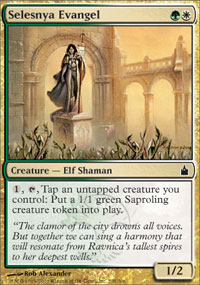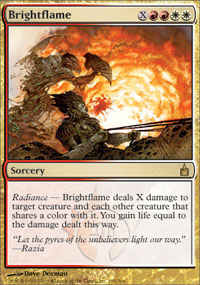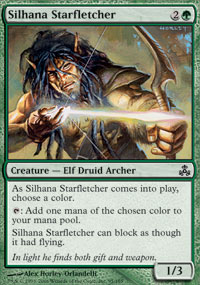
Unlike anything before it. That's the least you can say about the Ravnica-Guildpact-Dissension draft format. It's a lot of fun, but it's insanely complex. At Pro Tour: Prague, the pros had to figure out how to survive three packs of different Gold cards. Eight players emerged on top for the final draft; eight players who, apparently, understood this crazy format better than everyone else. What can we learn from them? I am here to analyze the last draft, which would determine the winner of this Pro Tour. But first, let me introduce you to my friend: winner of the Nobel Prize for Computer Codes 2005 and the Official Best Thing Since Sliced Bread Award, without which this article could not have touched upon the borders of existence... the Draft Viewer.
You don't actually need the Draft Viewer open to understand the article, I mention the important cards in each pack; but if you like to have more background or just like to have the pictures, feel free to follow the packs in the Draft Viewer. It might just be easier anyway. Before I start, a few disclaimers:
1) I am assuming basic Limited knowledge. This article is Drafting: Advanced. This means I'm not wasting time explaining what the good cards in the pack are or why. This article is about what is special in RGD drafts; in other words, when a card gets picked over better cards and what the reasons behind that are. If you need basic knowledge about what cards are good, there are other places to look (for example our recent Dissension Limited Review).

I have eight Lab Rats to study.
3) In my search for an explanation of the behavior of my eight lab rats, I'm never going to assume they made a mistake. Even the best players make mistakes, so this isn't entirely correct; however, my ego is just not big enough to think that I should be judging whether they were right or wrong. So let's just say they're always right, 'cause you know, they probably are most of the time. Besides that, there's not always an absolute right or wrong in drafting; much also depends on personal preferences of the players.
4) The part where you can shoot on me if you really want to, is the paraphrasing of their thoughts, intentions and strategies. I try to understand those based on what they pick, but since I'm not psychic there's no way to be sure if they were actually thinking what I think they were thinking. Uh. You know what I mean. Let's get started.
Ravnica
You might think you know how to draft the Ravnica cards by now, being experienced with the RRR and RRG formats. Nothing is less true. RGD is a totally different animal. Pretty much by definition of this format, the decks that worked best in those older formats work worst in RGD. The most important factor is that there is no "returning" pack of Ravnica, making signalling much less clear. If you manage to signal that you are in Boros, and the guy behind you cooperates by taking Dimir cards, you might still end up fighting each other over Orzhov cards! But if sending a clear signal is no longer a priority, what should you be taking? Let's see what our pros do, and we will learn some rather surprising things. We will see that the Ravnica pack is where the differences between this draft format and any other are at its largest: there seem to be some rules about the draft all of these players follow.
Martin (Seat 8) and Osawa (Seat 1)
Osawa opens Char, and is then presented with the choice between Hammerfist Giant, Oathsworn Giant, Peel from Reality and Skyknight Legionnaire next. He takes Peel. Unfortunately for him, Martin took Vedalken Dismisser from that pack. Martin's second pick is quite remarkable, especially considering his Dismisser: Cleansing Beam over Peel from Reality. He seems to be aiming for Izzet, but will need to cut Blue hard after this, because Osawa takes the Peel and is sent into the exact same combination. Martin receives Brainspoil and Golgari Rotwurm as the best cards in the pack next; he could stay on colour by taking the now mediocre Vedalken Entrancer or Lurking Informant, or Sparkmage Apprentice in red, but opts for more power in Brainspoil. Osawa does the same and takes Rotwurm, despite having four different colours now and having just passed a Rotwurm, which Sibast (Seat 2) took.
Martin is clearly aiming for a defensive deck, as his next pick is Dimir House Guard over Halcyon Glaze and Woebringer Demon. Osawa's pick from this pack really shows his skill: despite the Glaze in the pack and the two Peels he drafted, he realizes Blue is not open. The two passed Rotwurms, followed by the Demon (which is really a Golgari card) show him that Black-Green is open, and he doesn't fall for the Glaze trap. Indeed, Martin passes him two amazing cards in Scatter the Seeds and Golgari Rotwurm next, over which he took mana-fixing. Osawa is settled for BGR, while Martin expects goodness from at least one of Guildpact's two controlling guilds.
Already, from just looking at these two players, we can see some important tendencies for the Ravnica pack:
Rule Number One: Early in the draft, pick the card with the least coloured mana symbols in it. This is clearly demonstrated by Osawa's second pick, as well as Martin's fourth. The reason is simple: if possible, you would like to play the cards you pick so early, but you don't want to commit yourself to a colour combination yet before seeing what gets passed to you. Since everyone plays at least three colours, a card with a single coloured mana symbol will make the cut no matter what at least 60% of the time, and it can be splashed for as a fourth colour if you don't happen to get that colour.

When an off-colour card is clearly
better than the rest, take it.
Rule Number Two: Go for power. This one applies only after rule one, but is important as well. Don't be afraid to switch colours in the first pack; as we will see, most players will end up with all the different colours after pack one. This is made clear by the pack where Brainspoil and Rotwurm are taken ahead of worse on-colour cards. You have to ask yourself whether you will really miss the on-colour card in your deck. For the Entrancer and Apprentice in this pack, the answer is no, so they take the more powerful cards and keep their options open.
Rule Number Three: Draft Blue if you can. Blue is considered the most powerful colour in RGD, and as such all the Blue cards move up in the pick orders. Taking some Blue cards early on is good; if you're lucky, it's open ahead of you and you're settled for a great draft. Of course, you have to be ready to leave the ship when you see it's sinking: As I said in the second rule, be ready to switch if better cards arrive in another colour.
Sibast (Seat 2) and De Rosa (Seat 3)
Sibasts draft starts great with a Moldervine Cloak. Unfortunately the clear best card he passes is Siege Wurm. De Rosa's first pick wasn't as easy, as he opened a lot of powerful cards: Halcyon Glaze, Golgari Rotwurm, Scatter the Seeds, Viashino Fangtail, and Snapping Drake are the five best cards. He takes the Drake (a great example of the first rule), but has to take the Siege Wurm next by lack of alternatives.
In the second pack Sibast doesn't follow rule one and takes Bramble Elemental over Snapping Drake and Dimir House Guard. Several reasons can be found for that: his first pick was an incredible bomb, and he decides he really wants to stay in that colour, the Bramble has particular synergy with it, and Green is the colour where you can occasionaly sin against that rule because of its mana fixing. Perhaps the most important reason: after passing the Wurm, he wants to keep De Rosa out of Green, and this pack provides a great opportunity for it. This way he can get his hands on Gruul cards. I'm aware this part will probably evoke some reactions like "what a lot of talk about a simple pick; I'd have taken Bramble without a sweat." The problem is that you haven't adopted the first rule yet. It takes several solid reasons (bomb first pick, strong signal, etc) to ignore that rule. There will be several examples of that first rule during the draft, and you'll see it takes a lot not to follow it. Which is why I explain this one so extensively.
De Rosa logically takes the Drake from this pack. Sibast further follows up on his plan with an easy third pick in Hammerfist Giant. For De Rosa there's the Skyknight Legionnaire, apparently Blue and Boros are both open for him, so he seems to be nicely on the road to UWR. The next pack has a Golgari Rotwurm for Sibast; he must be really happy at this point as he seems settled for BGR. Unfortunately for him, Osawa in front of him is at this moment switching to that same archetype. For De Rosa there's a Tidewater Minion in this pack, which fits in his plans. Fifth pick Sibast takes Dimir Signet over Gather Courage, Recollect, and Darkblast, clearly valuing mana very highly. At this point he is probably anticipating the Simic cards he expects to see in pack three. (Remember also rule three: keeping a way open to Blue is never bad.)
Picks six and seven show he intends to draft five-colour if necessary, and he starts taking the Selesnya cards nobody wants anymore: Vitu-Ghazi and Pollenbright Wings. It's interesting to note that at the same time, pick seven, Crosby in Seat 5 is taking the Evangel which was shipped along at this side of the table. This is where Selesnya ends up these days. Meanwhile De Rosa has Benevolent Ancestor and the late Halcyon Glaze and is ready for UWR.

One day you're famous and everybody's
friend, next day they drop you like a stone.
First, Simic is stronger. Selesnya isn't bad either, but Simic is one of, if not the best among the guilds. Next, Selesnya is in Ravnica, which makes quite a difference. Ravnica is a big set, so it's less reliable to get the goodies from your Ravnica guild. To make things worse, the fifteen cards in your pack are spread between four guilds instead of three. All this means that the guild you choose in Ravnica is probably your least represented guild. Combine that with the fact that there are no "paths" through the three packs of Ravnica (so you have another "weak" pack no matter what) and you risk a poor and unreliable draft.
But the most important reason leads back to rule one. The idea behind that rule was: do not commit yourself early. And taking Selesnya cards is a huge commitment. Why? Green-White-Red and Green-White-Black are both poor combinations. After all, as said earlier pack one is all about switching colours and going after the most power, while trying to find the colour combination where you can "settle". Pack one should not be the one you most rely on to get two out of the three guilds you're playing. That leaves us with two archetypes: Green-White-Blue, which is decent but quite hurt by its lack of removal, and, more likely, 4- or 5- colour. Both of these plans are acceptable, but they aren't flexible. Taking Selesnya commits you to such a strategy, and the golden rule among these players is clearly: do not commit early. A clear example is Watchwolf: it's not very good in 4+ colour, so that leaves only GUW where it shines. As a result, the Wolves were seen lapping tables all day at the Pro Tour.
Huttenberger (Seat 4) and Crosby (Seat 5)
And the golden rule shows up again. Huttenberger opens Scatter the Seeds, Faith's Fetters, Compulsive Research and Dream Leash (and Pollenbright Wings, but we've already seen where that one will end up). And indeed, the first two cards to leave the pack are those with one mana symbol: Huttenberger has the Fetters and Crosby gets the Research. It's his second one actually, the first one got taken over Halcyon Glaze, Bramble Elemental, Woebringer Demon and Dimir House Guard (and Vitu-Ghazi.) It's as if these packs were made to illustrate this rule.

Do not commit yourself too early - taken
to the extreme.
Huttenberger's fifth pick however is very interesting. At this point he has Fetters, Fangtail, Turnkey and House Guard so he seems in good shape for RWB. But what we see is an extreme example of keeping his options open as he takes a Centaur Safeguard instead of Oathsworn Giant and Nightguard Patrol. Taking a White card locks him up too much, so he takes the card that can go into both RWB and GBR, a very surprising pick. Crosby has only Blue cards so far and happily takes the Giant: with White and Blue both open he may expect good Azorius cards in pack three! This is why he also can take the Evangel next pick, the WUG is a very realistic option at this point so now he can take the Evangel. (Besides, there were only good Green cards in the pack.) Huttenberger got an easy Stinkweed Imp from that pack; a Thundersong Trumpeter and Benevolent Ancestor after that lead him further into RWB, while Crosby happily takes the rest of the Blue cards.
Brackmann (Seat 6) and Nakamura (Seat 7)

Bombs can still go first.
Brackmann meanwhile saw a good opportunity to cut Green hard with a second pick Bramble Elemental over the aforementioned House Guard and the Black-Green committing Woebringer Demon in the pack. Third pick shows again the rule of power over signals with the Dream Leash over Scatter the Seeds. There are no Boros cards for Nakamura in the pack. Pollenbright Wings and the Seeds are no options for him as RWG has to be avoided; he has to go RWU or RWB. The only good non-Green card in the pack is the Tidewater Minion. The rest of Nakamura's draft is uneventful as he gets decent Boros cards picks five to eight.
Brackmann has seen a lot of Green and Blue cards, so at this point he must be hoping that trend will continue in pack three so he can get the Simic goodness. In this light his pick of Scatter the Seeds over Golgari Rotwurm is only logical as that card is nuts in Blue-Green. This and Nakamura's Boros-drafting (Thundersong Trumpeter from this pack) explain the late Rotwurm, which will end up in Osawa's winning deck. Next comes the two weak packs. Brackmann takes Terraformer over Selesnya Sanctuary. He clearly doesn't want White to be his third colour; indeed the only logical choice is Red, even with no Red cards picked yet! Guildpact will provide him with two guilds he can pick from, though, and Simic already shows itself to be open in front of him, so he is in great shape for UGR.
Rule Number Five: Once you know what is open in front of you, jump into it. Sending signals is nearly impossible in this format, but reading them is more important than ever. And yes I am aware of the contradictio in terminis in that you're reading unsent messages. This follows from the second rule more or less: by taking the most powerful card in the pack you stay out of the colours of the person in front of you. Now, the tricky bit is of course: when do you know what is open? Usually this seems to be around pick five, but in Nakamura's case it was the third pick after getting the second pick Lightning Helix. (Of course his Brightflame played a role in this too.) Note that there is probably quite a discrepancy between this table and your next draft table. Deducing what is open in front of you can be very hard, and we mortal players can only try to improve at this part.
Guildpact and Dissension
Packs two and three work quite different. For some of the players, they will be significantly simpler: those that are already firmly locked into a "three-guild" archetype with one guild from each set. Officially five of these exist: Boros-Izzet-Azorius, Boros-Orzhov-Rakdos, Golgari-Gruul-Rakdos, Dimir-Izzet-Rakdos and Dimir-Orzhov-Azorius. Unofficially, you should immediately add a sixth one: Gruul-Izzet-Simic. This one uses no guild from Ravnica, but that's quite easy to survive for the same reasons as explained under the "avoid Selesnya"-rule: in pack one you have less opportunity to draft your guild. Add to that the fact that this combination has a lot of raw power, great synergy between Bloodthirst and Graft, and that Green and Blue both have enough solid mono-coloured picks in Ravnica, and you see why we can consider this archetype at least as good as the other five.
When you're in one of these "safe" combinations after pack one, the rest of the draft becomes a rather normal draft. Basically you "just" have to take the best on-colour card from each pack, of course while looking after synergy, mana curve, reliable mana, creature/spell mix, etc. Obviously that's not as simple as it sounds, but at least it's normal drafting. Since this isn't specific for the crazy RGD format, I won't go into such detail about the rest of draft. The differences between RGD and other draft formats are mostly in the first pack.
So, who of the drafters had a relatively simple draft after pack one?

This guy definitely proved his value.
De Rosa (3) was all set up for crazy Izzet cards in pack two and had a very nice UWr deck, barring some mana issues.
Huttenberger (4) drafted WBR, but Crosby (5) behind him chose UWb (over the also possible for him UWG), meaning they both wanted the Orzhov cards. This changed Huttenberger's draft significantly, and he was forced to WBrg. Even one of the good combinations is no guarantee for an easy draft!
Brackmann (6), as I said above, was settled for UGr without taking a single Red card in pack one. Getting no less than three Silhana Starfletcher in pack two meant he could easily take a second-pick Seal of Doom from the third pack.
Nakamura (7) was firmly in Boros after pack one but had the luxury to go either Blue or Black as his third colour. It ended up being RWb.
Martin (8) was mostly in Rakdos colours after the Ravnica pack, and he quickly found the Orzhov cards in pack two with picks one to four Mortify, Pillory of the Sleepless, Ostiary Thrull, Orzhov Signet for an RBw deck.
Rule Number Six: Try to settle in one of the six archetypes mentioned above. Six of these eight players opt for one of these three-guild combinations. In the case of Huttenberger, he splashed Green because of a second pick Savage Twister (with no competition from Orzhov cards, as Crosby had taken the Shrieking Grotesque in the pack). Sibast (2) on the other hand ended up with those late Selesnya cards, and then it's hard to avoid going four colours (Gbwu in his case). It's also a solid strategy, just not a flexible one, as I explained earlier. It's fine to end up with this deck, but you shouldn't aim for it.
What have we learned today?
These are the rules of thumb:
The Golden Rule: Do not commit early.
In the first few picks, take cards with fewer coloured mana symbols.
Go for the most powerful cards; don't be afraid to switch colours during pack one.
If you have the chance, draft Blue. It's the best colour.
Avoid Selesnya in the early picks. It forces you into one archetype.
Around pick five, you should know what is open and jump into it. Now you can go for one decktype.
Among those decktypes, the following are preferrable: GBR, GUR and BWR; UWR, UWB and UBR; UWG or Gxxx variants. RGW, GWB and GBU are out of the question.
Finally, here's some wisdom that applies to most games, not just Magic: a good player knows the rules of thumb and can use them; a great player also knows when to break them. But for most of us, becoming good at drafting is probably enough as a goal for now. Have fun drafting, because, in case I forgot to tell you amongst all the analyzing: RGD is an incredibly fun draft format. Understanding it can only make it more enjoyable, and I hope I could provide some help with that.
-Tahn
Comments